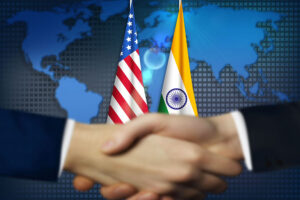GS2 – International Relations

Context:
Amid evolving U.S. policies and geopolitical priorities, India–U.S. relations have encountered fresh challenges. A strategic reassessment is essential to safeguard mutual trust and ensure sustained alignment in the long term.
Reasons for Tensions in Bilateral Relations
- Transactional vs. Strategic Mindsets:
The U.S. often engages in short-term, deal-oriented diplomacy, while India emphasizes civilisational ties and enduring partnerships. This difference, particularly evident during Donald Trump’s unpredictable tenure, created unease in New Delhi’s strategic circles. - Resurfacing of India–Pakistan Linkage:
Actions like President Trump’s comments after Operation Sindoor, which placed India and Pakistan on the same plane, signaled a regression to the outdated “hyphenation” approach in U.S. foreign policy. - Mixed Economic Messaging:
While the U.S. has voiced support for India’s role in the Indo-Pacific, contradictory signals—such as discouraging Apple’s manufacturing shift to India—raise doubts about the credibility of that support. - Immigration-Related Tensions:
Tighter H-1B visa norms strain the technology ecosystem and undermine a key pillar of bilateral cooperation—innovation and skilled migration. - Strategic Disconnect:
India’s sovereign, multipolar foreign policy is often misread by Washington as indecisiveness or lack of commitment, rather than strategic autonomy.
Note: Hyphenation refers to the practice of the U.S. treating India and Pakistan as a combined concern in foreign policy, rather than engaging with each on its own merit.
Consequences of This Strain
- Undermining India’s Global Position:
Reintroducing parity with Pakistan diminishes India’s growing global stature and independent identity in international affairs. - Weakening Defence Trust:
U.S. gestures—like welcoming Pakistan’s military leadership or CENTCOM’s public praise—raise questions about the depth of the India–U.S. security partnership. - Concerns on Counterterrorism Cooperation:
Continued U.S. engagement with Pakistan, despite its history of backing cross-border terrorism, generates skepticism in India regarding America’s counterterrorism commitments. - Over-Reliance on Familiar Patterns:
The U.S. appears to revert to traditional familiarity with Pakistan, overlooking its duplicity, especially evident in Afghanistan.
CENTCOM: U.S. Central Command is responsible for American military operations across the Middle East, Central Asia, and parts of South Asia, including Afghanistan and Pakistan.
Strategies to Strengthen and Stabilize Relations
- Measured and Principled Engagement:
India should avoid reactive diplomacy and instead focus on issue-based cooperation—particularly in defence, the Quad, and intelligence sharing—while maintaining a clear, consistent diplomatic tone. - Widen U.S. Engagement Channels:
Strengthening ties with U.S. lawmakers, policy think tanks, and the influential Indian-American community can help ensure bipartisan and sustainable support. - Rebuild Economic Trust:
Negotiating incremental but impactful trade agreements and urging the U.S. to address immigration and investment-related apprehensions can renew economic confidence. - Promote Shared Democratic Values:
Shifting the narrative from merely balancing China to building a democratic, rule-based Indo-Pacific order offers a positive, value-driven vision. - Reframe Skilled Migration:
Position H-1B visas not as concessions, but as vital enablers of innovation and economic synergy. - Focus on Joint Innovation:
Collaborate on emerging technologies, artificial intelligence, and sustainable energy to make co-innovation a cornerstone of the partnership.




